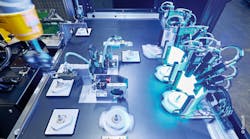InspectorOne is based on deep learning and features the XPlanar system from Beckhoff to enable adaptive material handling flows. In one application, for example, the system allows an automotive supplier to achieve extremely short cycle times of just three seconds when inspecting high-pressure injection valves. That adds up to inspection of roughly six million parts per year in three-shift operation.
Modularity is a crucial factor for the InspectorOne, explains Simon Mohr, laser technology expert at Stoba: “Depending on the application and testing process, the system includes not only different types of stations, but also different numbers of stations, such as camera systems for surface inspection and measurement technology for component measurement or code readers. This can be defined on a modular basis according to application requirements, just as XPlanar as the central handling unit can be adapted via the respective number of tiles and movers.”
Error-free testing
The InspectorOne currently being implemented at an automotive parts supplier is an optical testing machine for high-pressure injection valves. Robots load and unload the valves onto XPlanar movers.
• Complete 360-degree rotation simplifies full inspection of each part on just one XPlanar mover.
• Multiple movers per system support simultaneous inspection of different components on one machine.
• Parts are inherently traceable due to mapping of movers in the fully integrated Beckhoff control system.
With these advantages, the automotive supplier can more effectively detect any surface defects, contamination, particles in liquids or air bubbles in the material, guaranteeing greater part quality. The InspectorOne system is also equipped with machine vision cameras and deep-learning software. This enables it to continuously improve its capabilities, optimizing for faster component scanning and enhanced detection of features or anomalies.
Optimized process flow
The XPlanar movers not only transport components to the individual inspection stations, they also optimize the process flow due to the system’s multiple degrees of freedom in movement.
“XPlanar enables short cycle times, which would be difficult to achieve even with a rotary indexing machine. It is also an extremely flexible and easily customizable modular system,” Mohr says. “The floating movers represent a wear- and abrasion-free material handling technology, which makes them ideal for use in clean rooms. This would not have been feasible with linear guides or rotary indexing machines.”
Alternative concepts, such as a rotary indexing machine, would require significantly more mechanical design, according to Michael Berkner, a sales expert for laser technology at Stoba.
Testing with less maintenance
“XPlanar eliminates mechanical abrasion, which makes for an extremely low-maintenance system overall. This has a positive effect, especially with the frequent product changes throughout the year,” Berkner says. “XPlanar also allowed us to achieve a particularly compact machine design, saving us around 15-20% in floor space compared to conventional systems.”
The reduced need for maintenance also improves the overall efficiency of the system, as less maintenance frees up more time for testing. According to Stoba, this is directly evident in testing operations, in that the floating product transport avoids abrasion and minimizes microparticle contamination in the components. In the event that particles of this nature are present, they are detected as an anomaly by the deep-learning software, even if it is not an actual component defect.
System adaptability
“If you consider the long service life of the system as well as the different product life cycles, replacing mechanics with the software functionality of XPlanar becomes decisively more important,” Mohr says. Standard TwinCAT software functionality is used to control the movers and motor tiles from Beckhoff. “A flexible system such as InspectorOne can be adapted to new components or changed inspection requirements over many years by simply replacing or adding the respective inspection stations. As far as the changed product transport goes, it is sufficient to perform updates via software.”
Berkner adds that Stoba is also “looking into component-specific formulas for the motion profiles of the XPlanar movers so that we can test different components batch by batch without interrupting the production process. This would simply not be feasible with a mechanical conversion.”




